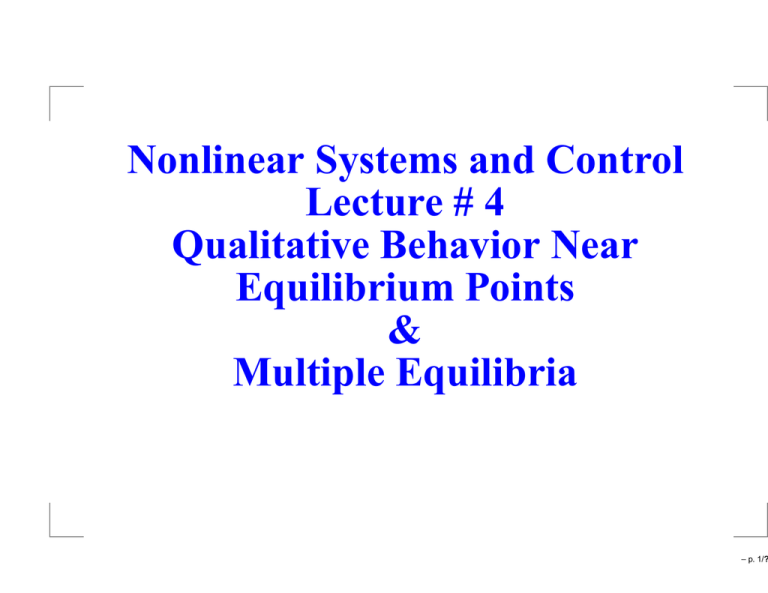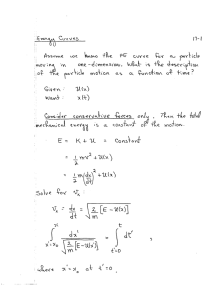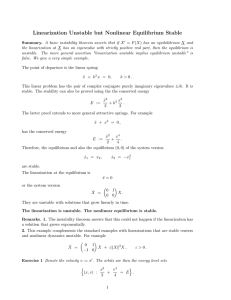Nonlinear Systems and Control Lecture # 4 Qualitative Behavior
advertisement

Nonlinear Systems and Control Lecture # 4 Qualitative Behavior Near Equilibrium Points & Multiple Equilibria – p. 1/? The qualitative behavior of a nonlinear system near an equilibrium point can take one of the patterns we have seen with linear systems. Correspondingly the equilibrium points are classified as stable node, unstable node, saddle, stable focus, unstable focus, or center Can we determine the type of the equilibrium point of a nonlinear system by linearization? – p. 2/? Let p = (p1 , p2 ) be an equilibrium point of the system ẋ1 = f1 (x1 , x2 ), ẋ2 = f2 (x1 , x2 ) where f1 and f2 are continuously differentiable Expand f1 and f2 in Taylor series about (p1 , p2 ) ẋ1 = f1 (p1 , p2 ) + a11 (x1 − p1 ) + a12 (x2 − p2 ) + H.O.T. ẋ2 = f2 (p1 , p2 ) + a21 (x1 − p1 ) + a22 (x2 − p2 ) + H.O.T. a11 a21 ∂f1 (x1 , x2 ) = , ∂x1 x=p ∂f2 (x1 , x2 ) = , ∂x1 x=p a12 a22 ∂f1 (x1 , x2 ) = ∂x2 x=p ∂f2 (x1 , x2 ) = ∂x2 x=p – p. 3/? f1 (p1 , p2 ) = f2 (p1 , p2 ) = 0 y1 = x1 − p1 y2 = x2 − p2 ẏ1 = ẋ1 = a11 y1 + a12 y2 + H.O.T. ẏ2 = ẋ2 = a21 y1 + a22 y2 + H.O.T. A= a11 a12 a21 a22 ẏ ≈ Ay ∂f ∂f1 1 ∂x1 ∂x2 = ∂f2 ∂f2 ∂x1 ∂x2 x=p ∂f = ∂x x=p – p. 4/? Eigenvalues of A Type of equilibrium point of the nonlinear system λ2 < λ1 < 0 Stable Node λ2 > λ1 > 0 Unstable Node λ2 < 0 < λ1 Saddle α ± jβ, α < 0 Stable Focus α ± jβ, α > 0 Unstable Focus ±jβ Linearization Fails – p. 5/? Example ẋ1 = −x2 − µx1 (x21 + x22 ) ẋ2 = x1 − µx2 (x21 + x22 ) x = 0 is an equilibrium point " # ∂f −µ(3x21 + x22 ) −(1 + 2µx1 x2 ) = (1 − 2µx1 x2 ) −µ(x21 + 3x22 ) ∂x " # ∂f 0 −1 A= = 1 0 ∂x x=0 x1 = r cos θ and x2 = r sin θ ⇒ ṙ = −µr 3 and θ̇ = 1 Stable focus when µ > 0 and Unstable focus when µ < 0 – p. 6/? For a saddle point, we can use linearization to generate the stable and unstable trajectories Let the eigenvalues of the linearization be λ1 > 0 > λ2 and the corresponding eigenvectors be v1 and v2 The stable and unstable trajectories will be tangent to the stable and unstable eigenvectors, respectively, as they approach the equilibrium point p For the unstable trajectories use x0 = p ± αv1 For the stable trajectories use x0 = p ± αv2 α is a small positive number – p. 7/? Multiple Equilibria Example: Tunnel-diode circuit ẋ1 = 0.5[−h(x1 ) + x2 ] ẋ2 = 0.2(−x1 − 1.5x2 + 1.2) h(x1 ) = 17.76x1 −103.79x21 +229.62x31 −226.31x41 +83.72x51 i R 1 Q1 = (0.063, 0.758) Q2 = (0.285, 0.61) Q3 = (0.884, 0.21) 0.8 0.6 Q 1 Q 2 0.4 Q 3 0.2 0 0 0.5 1 v R – p. 8/? ∂f ∂x " = " −0.5h′ (x1 ) 0.5 −0.2 −0.3 # −3.598 0.5 A1 = , −0.2 −0.3 " # 1.82 0.5 A2 = , −0.2 −0.3 " # −1.427 0.5 A3 = , −0.2 −0.3 # Eigenvalues : − 3.57, −0.33 Eigenvalues : 1.77, −0.25 Eigenvalues : − 1.33, −0.4 Q1 is a stable node; Q2 is a saddle; Q3 is a stable node – p. 9/? 2 3 4 5 x ’ = 0.5 ( − 17.76 x + 103.79 x − 229.62 x + 226.31 x − 83.72 x + y) y ’ = 0.2 ( − x − 1.5 y + 1.2) 1.5 y 1 0.5 0 −0.5 −0.5 0 0.5 1 1.5 x – p. 10/? Hysteresis characteristics of the tunnel-diode circuit u = E, i y = vR y R 1.2 1 1 0.8 0.8 0.6 Q 1 Q 2 0.6 D 0.4 0.4 Q 3 0.2 0 0 F C 0.2 0 0.5 1 v R E 0 B A 1 2 3 u – p. 11/?







